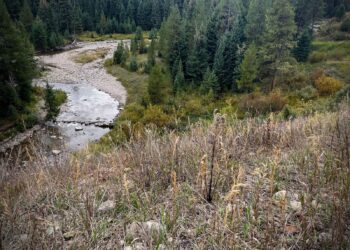By Jessianne Wright EBS CONTRIBUTOR
BOZEMAN – Stephanie Lynn, the education and communications coordinator for the Gallatin River Task Force, regularly traversed approximately 4 miles of trail along Porcupine Creek between 2015 and 2017, returning each time with 1 liter of river water collected in a stainless-steel canteen. She also collected water from the confluence of Porcupine Creek and Gallatin River.
Lynn and her study partner Nancy Sheil also cross-country skied the 4 miles in order to get to their assigned sample site on Porcupine Creek in the snow; they ran or mountain biked there in the summer.
After collection, they turned the samples in to the Bozeman research group Adventure Scientists, who then shipped the water to Maine for analysis, in order to look for plastic pollution in the river.
While Lynn and Sheil only collected about 16 liters of water during the study, their effort came together with more than 700 samples gathered by 117 volunteers, taken from 72 sites throughout the Gallatin River watershed.
The results of this project, completed in the fall of 2017 and currently under scientific review and analysis, indicate that the Gallatin River system contains tiny bits of plastic.
The Gallatin study is the first close look at microplastics in a single watershed and emerged after Adventure Scientists worked on a global microplastics initiative. Around the world, researchers found 89 percent of marine samples and 51 percent of freshwater samples contained microplastic pollution.
Including portions of the watershed within Yellowstone National Park and extending through National Forest lands, a wilderness area and private property, the Gallatin study encompassed the reaches of the mainstem of the Gallatin, from the headwaters in the park to the confluence with the Missouri River northeast of Three Forks, as well as the many tributaries.
Adventure Scientists partnered with the Gallatin River Task Force to design the study and identify sample sites throughout the watershed. Trained volunteers collected water from assigned sites over the course of two years, returning seasonally in September, December, March and June.
While the data is still under analysis, project leader Katie Christiansen was able to confirm microplastics throughout the mainstem of the Gallatin. Perhaps surprisingly, the pollution was found within Yellowstone and at remote tributary headwaters.
For Christiansen, finding plastic pollution in the Gallatin is alarming. “Microplastic is a global issue, it’s evidence of human effects on the environment,” she said. “There’s enough agency in mankind to affect the environment in such a huge way.”
Christiansen, who holds a master’s from the Yale School of Forestry and Environmental Studies, went on to describe recent studies on microplastics in the environment. Originating from the degradation of a variety of synthetic, plastic materials, microplastics are very small—less than 5 millimeters in diameter— and can be found as fibers, beads or fragments. They emerge in a variety of ways, such as when a tire wears on the road, clothing is laundered, or while a plastic bag breaks down in the sun.
Once the microplastic enters a waterway, it’s possible for small organisms like plankton to mistake the plastic for a food source. The plastic can become an obstruction and lead to starvation, or it can introduce toxins to the organism if chemicals adhered to the plastic before consumption.
“Imagine a plankton eats that microplastic,” Christiansen said. “Then a fish eats 1,000 plankton. Then a larger fish eats 100 of those smaller fish. Microplastic doesn’t cause obstruction [for the fish], but it’s likely carrying toxic chemicals that the fish wouldn’t be exposed to at that concentration.” Peer-reviewed studies have found these toxins to impact a fish’s ability to feed and reproduce, she added.
Research on microplastics is an emerging field, and studies have not been conducted on the impacts of microplastics on humans, if we consume them in our drinking water or are exposed to carried toxins in our seafood.
Microplastics are now understood to enter waterways in a variety of ways, not necessarily just through a point source like effluent discharge from a treatment facility. The tiny plastic particles, in fact, can travel atmospherically in the air, explaining why the plastic was found in remote locations of the watershed. The microplastics also can be shed by clothing and materials used by outdoor enthusiasts.
Specific to the Big Sky samples, Christiansen said, “There wasn’t a sample site in Big Sky that was a significant contributor to microplastic pollution in the watershed, which is of note as Big Sky is a developing area experiencing growing human influence and is equipped with multiple wastewater treatment facilities.”
While there are many questions yet to be answered, Christiansen said there are several things we can be doing on an individual basis to at least reduce the spread of microplastics. This includes avoiding cosmetics that contain microbeads, including several types of toothpaste; washing synthetic items less often and selecting natural fibers when possible; purchasing a filter for the washing machine; and using less plastic when possible, such as when going to the grocery store.
Christiansen said with the conclusion of this research, residents in the Gallatin watershed could become leaders in microplastic response. “What we have now is a dataset that no other community has about pollution.”
For more information on the Gallatin microplastics research, visit adventurescientists.org/gallatin-microplastics.














